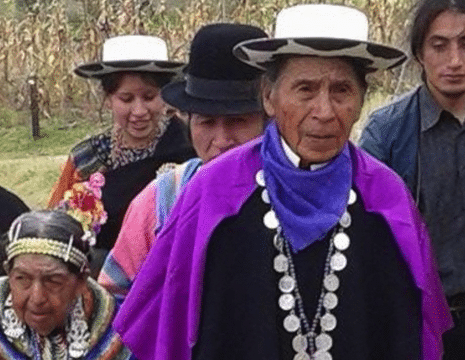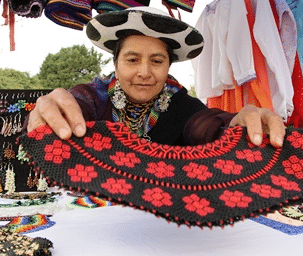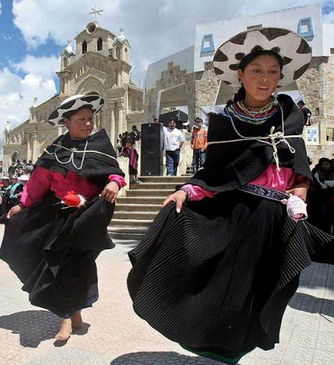The Saraguros maintain their independence and strong cultural ties to their Inca ancestors
By David Morrill
With the notable exception of the Otavalan craftspeople and merchants, no other indigenous Ecuadorian community has maintained its ethnic identity like the Saraguros.

Among Ecuadorians, the Saraguro people stand out for their distinctive dress.
Centered around the town of Saraguro, 75 miles south of Cuenca, the Saraguro nation, which numbers between 30,000 and 40,000, has maintained an enduring presence in the rural areas of the southern Ecuadorian provinces of Loja, Azuay and Zamora Chinchipe; some say it dates back 500 years, others say for much longer.
Although they have recently developed a strong crafts tradition, the Saraguros are best known to the outside world for their distinctive appearance. They dress in black, women in home-woven pleated skirts, men in knee-length trousers. Both wear matching woolen ponchos, often with shawls with orange and red accents, and white felt hats. Both men and women keep their hair in a long, single braid.
Many claim that the black dress is a sign of respect and mourning for the Inca leader Atahuallpa, betrayed and murdered by the Spanish, who ruled the area before the conquest; others, however, say originated much later. Whether the story is true or not, it bolsters the Saraguros’ strong respect and connection to the Incas. Many within the community, in fact, claim direct Inca ancestry.

In recent decades, Saraguro has developed a tradition for fine handicrafts.
Researchers say the ties to the Incas are real. Archeological evidence, including DNA results, suggests that many Saraguros are descendants of the mitmaqkuna, populations forcibly relocated by the Incas from the Lake Titicaca region of what is today Bolivia. In addition, Saraguros are also drawn from local populations including the Shuars of the Amazon basin highlands, and the Cañari from around current-day Cuenca, Azogues and Cañar.
The connection to the Inca is also reflected in tradition. Many Saraguros continue to work under an agricultural system of shared obligation between neighbors and the broader community. Although the community lacks a strong, centralized government, a belief in sharing and reciprocity and strong family networks has allowed the system to survive for centuries.
Anthropology researcher John Allison of Florida State University, who studied the Saraguros from 2004 to 2007, says the system is a product of the Inca heritage. “It was one of the reasons why the Incas were so successful. It puts the burden and responsibility on the smallest social unit of the society, the family, and that is why is has proven so enduring.”

The Inca emperor Atahuallpa is still revered among many Saraguros.
Anthropologists are also fascinated by the apparent sexual equality among the Saraguros. “Equal value was placed on the work of women and men as was their importance to the family,” says Allison. “It was understood that a good life is the result of equal responsibility and equal benefit.”
Although the Saraguros were placed under a system of forced labor and tribute by the Spanish in the mid-1500s, they were able to maintain a large degree of independence. “The Saraguros were fierce warriors and the Spanish were content to keep their distance so long as they received a share of the produce,” says Allison. “Records indicated that in armed conflict, the Saraguros often came out on top. In a real sense, they were never really conquered.”
In the early 1800s, after Ecuador won its independence from Spain, the new government continued the hands-off approach. “There isn’t any documentary evidence but it appears that the government had an agreement with the Saraguros to allow them to maintain their communities as they saw fit so long as tribute was paid,” says Allison. At the request of the government, the Saraguros maintained a system of tambos, or way stations, for travelers passing through the area.

Festivals and street performances are popular among the people of Saraguro.
Life has changed dramatically since the 1950s for the Saraguros, when the first roads reached the area and when the state-mandated system of forced labor and tribute came to an end. Many moved from rural areas to the town of Saraguro and became craftsmen and merchants. In the 1960s, Saraguro children were allowed, for the first time, to attend public high schools. Since then, many have gone on to universities in Ecuador and abroad.
Although the Saraguro economy continues to center on agriculture, the community increasingly emphasizes its hand crafts, primarily textiles, jewelry and ceramics, and is building a strong tourist trade. Efforts are underway to excavate nearby Incan ruins to broaden tourist appeal.
Despite the changes, the Saraguros show a dogged allegiance to their heritage, not only in their family and agricultural traditions and dress. Many continue to speak Quechua, the language of the Incas; children and public places are named for Incan princes; and many continue to participate in Inca ceremonies. “These are proud, independent people,” says Allison. “They have no intention of abandoning their past.”





















